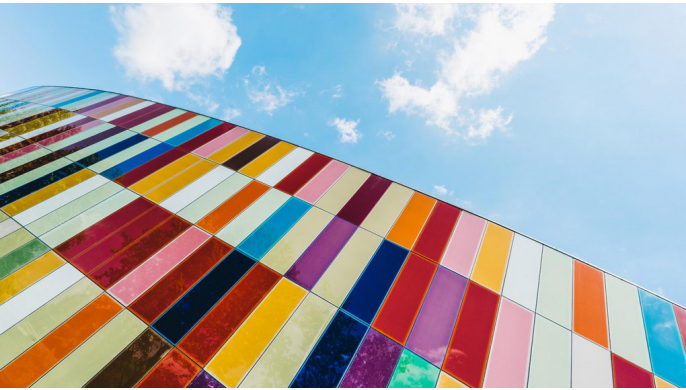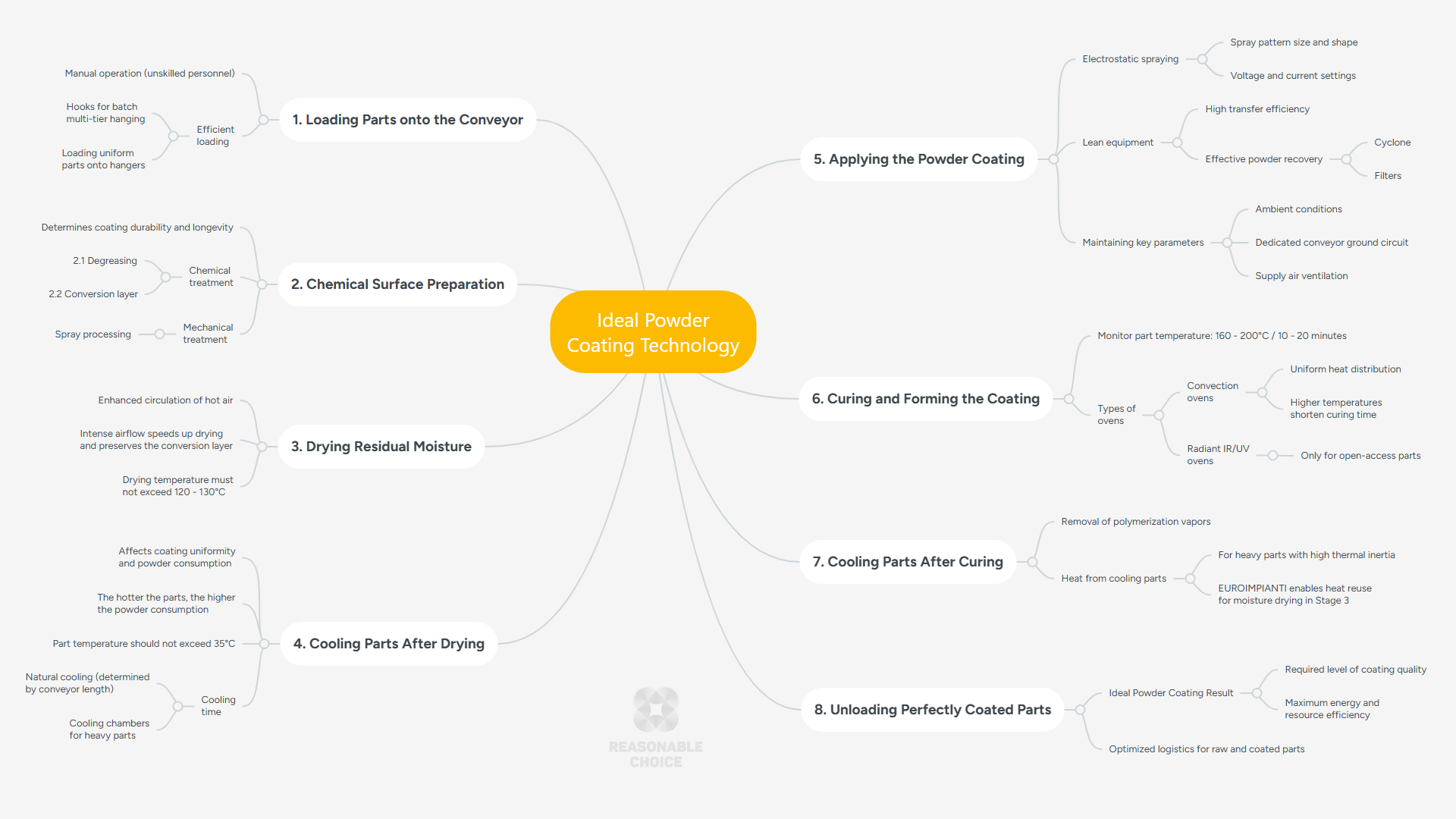Ideal Powder Coating Technology

It is often assumed that using powder coatings automatically guarantees high-quality and cost-effective polymer finishes. However, this is far from true. This article explores the complete technological cycle and key factors that, when properly addressed, can significantly improve coating quality and reduce the overall cost of powder coating.
Powder Coating Process Stages
The complete powder coating process includes the following essential stages:
- Loading parts onto the conveyor;
- Chemical surface preparation;
- Drying residual moisture in the oven;
- Cooling parts after drying;
- Applying the powder coating;
- Curing and forming the coating;
- Cooling parts after curing;
- Unloading perfectly coated parts.

Each stage of the process requires strict control of temperature and processing time. For this reason, the lengths of all active zones are designed in accordance with the conveyor's operating speed.
We design lines based on the ideal powder coating technology to ensure high-quality finishes with minimal energy and resource use.Powder Coating Lines
Let’s take a closer look at each stage of the powder coating process and highlight the critical details that contribute to achieving a flawless final finish.
1. Loading Parts onto the Conveyor

Efficient conveyor loading. To achieve maximum coating productivity, every linear meter of the conveyor should be used as efficiently as possible. The shape of the parts must be considered to determine the minimum distances required for full coverage of all surfaces.
Distance between hangers. Adjacent part hangers must not touch each other. A minimum allowable gap should be maintained to ensure their unimpeded movement through conveyor turns and inclines.
Hangers with uniform parts. It's best to divide the coating volume into series of similar parts. For each type, rational part hangers should be developed to enable compact, multi-tier loading.

Loading parts onto the EUROIMPIANTI automatic powder coating line
2. Chemical Surface Preparation

Surface preparation is a mandatory and most critical stage in the powder coating process. In a spray tunnel, parts pass through consecutive stages of high-pressure treatment, during which contaminants are removed, the surface is degreased, and a conversion layer is applied.
|
Important: Without proper chemical surface preparation, there can be no talk of an "ideal" powder coating process. Simply wiping parts manually with a cloth and solvent is not a valid method. Moreover, degreasing alone is insufficient — a proper conversion layer is essential for strong adhesion. |
Surface preparation cycles. To create high-quality conversion layers, different chemical cycles may be used: amorphous iron phosphating, crystalline zinc phosphating, advanced nanoceramics, and others. Learn more about surface preparation cycles.
What to consider. The choice of chemicals and treatment cycles depends on the specifics of the parts, the type of steel used, and the required durability of the final coating under actual operating conditions.
To ensure consistent quality of the conversion layer during surface treatment, it is important to maintain:
- proper concentration of chemical solutions;
- correct operating temperatures;
- sufficient processing time;
- purity of rinsing water.
Tunnel equipment. To automate the process and reduce the human factor, the spray tunnel should be equipped with automatic chemical dosing systems and solution regenerators.

Chemical and mechanical spray treatment removes contaminants, degreases the surface, and applies a conversion layer.
3. Drying Residual Moisture in the Oven

Enhanced air circulation. After rinsing, parts enter a convection drying oven with intensified hot air circulation. The stronger the airflow, the faster the drying process — and the lower the energy consumption required for heating.
Temperature control. The drying oven must maintain the recommended temperature range based on the surface treatment chemicals used. As a rule, the temperature should not exceed 120 - 130°C, as higher temperatures may damage the chemical conversion layer.

After the drying oven, parts exit fully dry with a uniform chemical conversion layer on the metal surface.
4. Cooling Parts After Drying

This stage plays a crucial role in powder consumption and achieving an even coating thickness. Most often, cooling takes place naturally as parts move from the drying oven to the powder spray booth.
Cooling time. During the design phase, the required cooling path length is calculated based on the conveyor speed and the time needed for parts to cool, taking into account their metal mass.

Example of extending the conveyor path after the ovens for the natural cooling of thick-walled parts.
For heavy, thick-walled parts, this stage can be accelerated by using dedicated cooling chambers with forced air circulation.

After drying, parts cool naturally as they travel the required conveyor length toward the coating booth.
5. Applying the Powder Coating

Electrostatic spraying is the primary method used in industrial powder application. Its popularity stems from high productivity, effective powder charging, and precise control of coating thickness.
Powder material accounts for 70–90% of the coating cost per square meter, depending on the powder price and coating thickness. That’s why optimizing the powder application process is a top priority in reducing overall costs.
Lean equipment helps regulate coating thickness and improve powder utilization rates. Choosing the right spray booth design, automatic guns, and powder recovery system is essential.
Key process parameters that must be controlled during powder application:
- Part temperature during spraying must not exceed 30 - 35°C. If the surface is too hot, the powder may melt upon contact, resulting in uncontrolled thickness and excessive material consumption.
- Dedicated grounding circuit for parts on the conveyor with a resistance no greater than 10 ohms. Clean hangers and hooks are also crucial to maintain proper conductivity.
- Spray pattern and shape, powder and air flow rates, voltage, current, and gun-to-part distance — all of these must be properly adjusted for each part type and stored in the control system. Correct settings help avoid issues like the Faraday cage effect and back ionization.
- Ambient conditions: Maintain 18 - 30°C temperature and humidity below 60% during both storage and application. Excess humidity and heat negatively affect the powder application process and reduce the service life of recovery system filters. Ideally, spraying should occur in an isolated room with conditioned, low-humidity air and controlled temperature.
- Supply air ventilation is essential for efficient operation of the powder recovery system. To ensure proper airflow through the cyclone and filters, supply air must enter the room — this ensures that powder is drawn into the recovery system and the area around the booth remains clean.
For additional strategies to reduce powder consumption, see our article on minimizing coating costs.

Coating booth with an automatic 5 + 5 guns for electrostatic powder spraying.
6. Curing and Forming the Coating

Curing cycle. At the final stage, powder-coated parts enter a curing oven, where the powder melts and undergoes a chemical polymerization (crosslinking) reaction at 160 - 200°C for 10 - 20 minutes. This process forms strong chemical bonds between polymer chains. As a result, the molten powder flows evenly over the metal surface, forming a smooth, uniform, and durable coating.
Heating parts to the required temperature. Curing occurs only once the part reaches the specified temperature. That’s why preheating time and the ramp-up to curing temperature must be considered — especially for thick-walled, heavy parts.
Main heat transfer methods used in industrial ovens:
- Infrared / ultraviolet radiant heating: energy from IR/UV emitters directly heats the illuminated metal surface. This method is suitable only for simple-shaped parts that can be fully exposed to radiation. Complex geometries with shaded areas cannot be evenly heated using radiant methods.
- Convection heating: heat is transferred via heated air circulating through the oven. Convection ovens ensure uniform heating regardless of part shape or wall thickness, which makes this method the most common in industrial powder coating.
Uniform heat distribution. The main function of a convection oven is to maintain even heat distribution throughout the entire oven volume — both along the conveyor path and across the height of the parts in the active "hot" zone. Temperature fluctuations should not exceed 5 - 10°C.
Time-temperature relationship. Modern thermosetting powders have well-defined curing curves that correlate curing time with metal temperature. The higher the part temperature, the shorter the required curing time. This gives process engineers the flexibility to adjust oven settings based on conveyor speed.

After the curing oven, parts have a uniform coating with the specified decorative and protective properties.
7. Cooling Parts After Curing

Extraction of curing fumes. As parts exit the oven, they pass over an exhaust system that removes volatile byproducts of the curing process. Depending on the line capacity, this system can be either natural or forced draft.
Cooling zone length. The length of the conveyor cooling zone is determined by the mass and wall thickness of the parts. Heavier, thick-walled components require more time to cool due to their thermal inertia, which results in longer conveyor paths.
Utilizing residual heat. Typically, the heat released by cooling parts is dissipated into the workshop — beneficial in colder months but an unwanted energy loss during warm seasons. A more effective approach is to recover this heat and use it in the drying stage after surface treatment.
Energy-efficient solutions: EUROIMPIANTI develops innovative multi-level cooling systems that recover heat from freshly cured parts and redirect it to partially heat the drying oven, reducing overall energy consumption.
8. Unloading Perfectly Coated Parts

Ready for unloading. Once the coated parts have naturally cooled to ambient shop temperature, they are ready to be unloaded.
Manual operation. In fully automated lines, loading and unloading the conveyor are the only manual tasks. These operations can be performed by low-skilled personnel, with staffing levels depending on conveyor speed, loading density, and the weight of the coated parts.

Manual loading of raw parts and unloading of cooled coated parts.
Ideal Powder Coating Result
The powder coating process can be considered ideal when it consistently delivers the required product quality with maximum efficiency in energy and resource use.
Technical Assignment (TA) for the coating line. To help you choose the right technology and equipment configuration, we need a Technical Assignment — the initial data required to design the line. Learn more about how to write a proper TA.
|
We take into account the type of product, its operating conditions, and expected service life. After weighing all the factors, we propose the optimal technology and line configuration — including the surface preparation cycle, number of coating layers, temperature and processing time at each stage. |
By implementing an efficient powder coating line with high resource utilization and recycled use of materials and energy, it is possible to achieve near-zero waste and the desired performance characteristics of the polymer coating.


